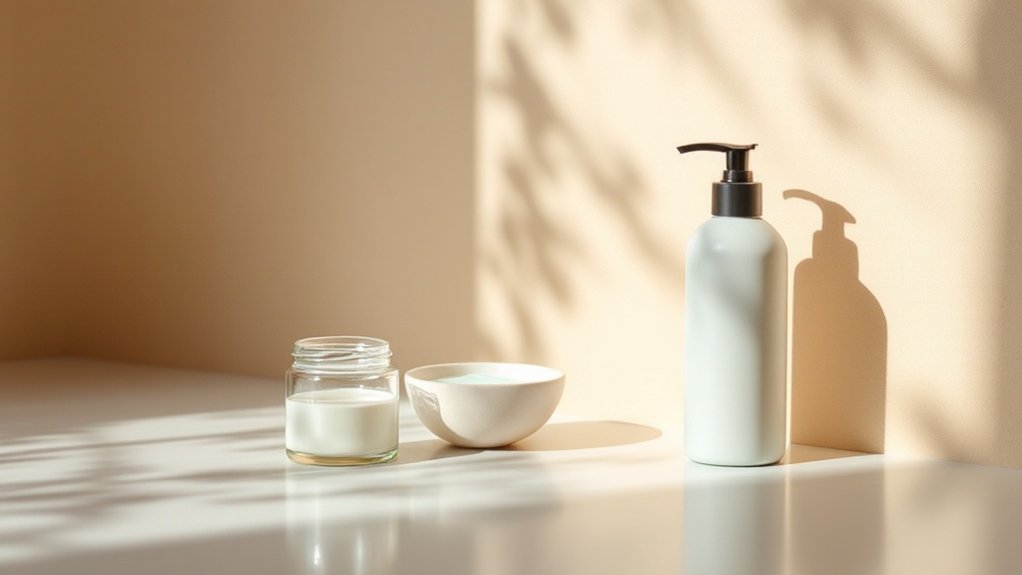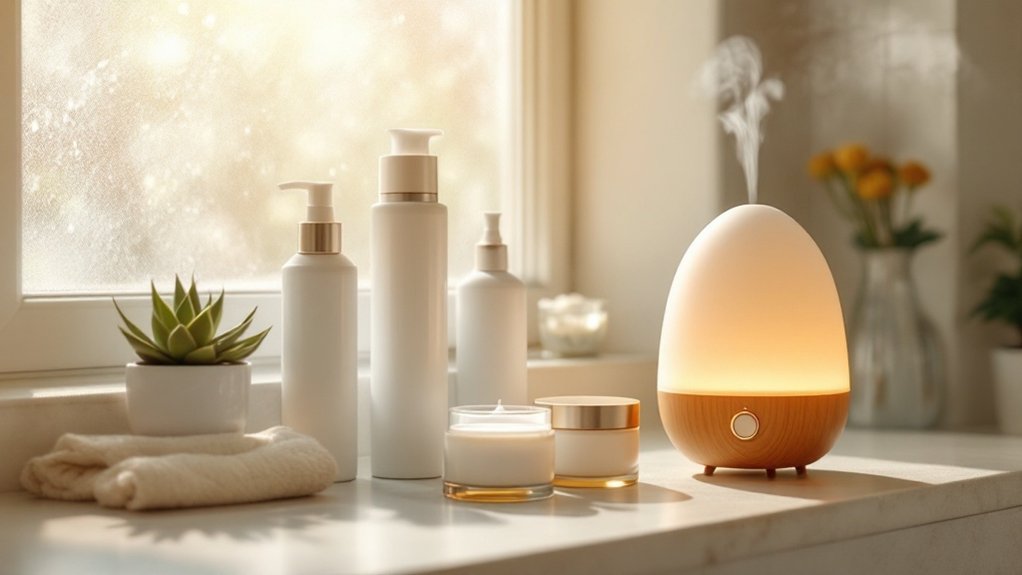Posted by: Skin And Cancer Institute in Medical Dermatology

Managing perioral dermatitis in arid environments requires strategic intervention. We recommend maintaining indoor humidity between 40-60%, implementing a minimalist skincare routine with gentle clay-based cleansers, and avoiding fluoridated products. Topical metronidazole or azelaic acid can effectively reduce inflammation, while oral antibiotics may be necessary for persistent cases. Eliminate fragrance, SLS, and heavy moisturizers that compromise barrier function. Documenting personal triggers creates a tailored approach for ideal skin restoration.
Key Takeaways
- Maintain indoor humidity between 40-60% using humidifiers to prevent skin barrier compromise in dry environments.
- Use gentle, clay-based cleansers once daily and avoid oils, emulsifiers, exfoliants, and heavy cosmetics.
- Switch to fluoride-free toothpaste to reduce irritation triggers common in perioral dermatitis.
- Apply fragrance-free moisturizers with ceramides and hyaluronic acid to support skin barrier function.
- Avoid topical corticosteroids which can worsen perioral dermatitis, especially in arid conditions.
How Dry Climates Affect Perioral Dermatitis

While perioral dermatitis can affect patients in any environment, arid climates greatly compromise the skin’s barrier function, creating favorable conditions for flare-ups. Low humidity environments trigger significant transepidermal water loss, leaving the perioral region vulnerable to irritation and inflammation.
We’ve observed that reduced ambient moisture stimulates pro-inflammatory cytokine release from keratinocytes while simultaneously increasing cortisol production and mast cell proliferation. This inflammatory cascade creates heightened reactivity to previously tolerated products. Additionally, sebum production decreases markedly in harsh conditions, further undermining skin hydration and protective capabilities. Using hyaluronic acid serums can help maintain optimal moisture levels in the affected areas.
Central heating systems and strong winds compound these effects, accelerating moisture depletion. For ideal climate adaptation, patients must understand this physiological response – the compromised barrier becomes increasingly reactive to mechanical stress and environmental irritants, perpetuating the dermatitis cycle. Winter months typically cause persistent worsening of perioral dermatitis symptoms due to the combination of cold temperatures and reduced humidity.
Recognizing Symptoms and Flare Triggers in Arid Environments
Identifying perioral dermatitis in arid environments requires systematic observation of both morphological characteristics and patient-reported sensations. We typically observe erythematous papules and pustules in a perioral distribution, with characteristic sparing of the vermilion border. In our practice, symptom awareness focuses on the burning or tingling sensations patients report, rather than severe pruritus. While the condition predominantly affects young women, representing 90% of cases, awareness of potential male presentations remains clinically important.
Trigger recognition is essential in arid climates where environmental factors notably impact disease course. Low humidity increases transepidermal water loss, while temperature fluctuations between air-conditioned interiors and hot exteriors stress the skin barrier. Additionally, heavy moisturizers and topical corticosteroids often exacerbate symptoms despite initial relief. We distinguish perioral dermatitis from seborrheic dermatitis by its distinctive distribution pattern and absence of yellow-white scales attached to hair shafts.
Building a Minimalist Skincare Routine for Compromised Barriers

Three fundamental principles guide our approach to minimalist skincare for perioral dermatitis patients with compromised skin barriers. First, we emphasize product elimination—avoiding all oils, emulsifiers, exfoliants, and heavy cosmetics in affected areas. Second, we advocate for single daily cleansing with gentle, clay-based formulations that provide mild antibacterial properties without disrupting natural defenses. Switching to fluoride-free toothpaste can significantly reduce irritation triggers that worsen perioral dermatitis symptoms. Natural skin oils are essential for maintaining proper hydration levels and preventing further irritation.
Our minimalist essentials protocol typically includes only two products: a non-foaming cleanser and a fragrance-free moisturizer containing niacinamide and sodium hyaluronate. We recommend product layering with 5-10 minute intervals between applications to optimize absorption and barrier repair. This simplified approach requires patient commitment through temporary dryness phases, but consistently delivers superior outcomes in compromised dermatitis cases, particularly in arid climates where barrier function is already challenged.
Effective Treatment Options for Desert Climate Sufferers
Beyond our minimalist approach, treating perioral dermatitis in desert climates requires targeted interventions that address the unique challenges of arid environments. At our practice, we’ve found that metronidazole and clindamycin topical therapies prove especially effective as first-line treatments, delivering anti-inflammatory benefits without adding excess moisture to compromised skin barriers. Regular skin barrier function monitoring helps detect early signs of inflammation and dryness.
For patients with persistent symptoms, we recommend oral medications like tetracycline (250-500mg twice daily) or doxycycline (100mg daily) for 8-12 weeks. These systemic treatments address underlying inflammation while accommodating the unique challenges of desert environments. In our clinical experience, some patients respond well to azelaic acid or sulfur-based products when prescription options aren’t feasible. It’s crucial to remember that using topical steroids can worsen perioral dermatitis rather than improve it.
We’re committed to monitoring your progress closely, adjusting treatment protocols as needed to guarantee peak outcomes for our desert-dwelling community.
Environmental Modifications to Support Healing

While effectively treating perioral dermatitis requires pharmaceutical intervention, environmental modifications play an essential role in supporting the healing process and preventing recurrence. We recommend maintaining indoor humidity between 40-60% using strategically placed humidifiers near sleeping and working areas. This creates moisture-rich microclimates that preserve skin barrier function. Using natural remedies like aloe vera gel can provide additional soothing benefits when applied to affected areas. Air purification systems greatly reduce airborne irritants that can trigger inflammatory responses. Additionally, we advise eliminating all fragranced products and those containing sodium lauryl sulfate from your home environment. For ideal healing during sleep, utilize hypoallergenic pillowcases and maintain consistent bedroom humidity control. When outdoors, implement extensive sun protection with broad-spectrum SPF 30+ sunscreen, protective clothing, and seeking shade during peak UV hours (10am-2pm). Living in arid climates requires extra moisturization due to increased water evaporation from the skin. These environmental adjustments create ideal conditions for dermatitis resolution.
Prevention Strategies for Long-Term Management
We recommend implementing a multi-faceted prevention approach that includes establishing protective skin barriers against environmental irritants through application of non-comedogenic physical sunscreens and targeted humidity protection. Simplifying your skincare routine can significantly reduce irritation and stress on the skin while minimizing exposure to potential inflammatory triggers. Our clinical experience confirms the efficacy of developing a personalized trigger identification system that meticulously documents exposure variables and corresponding skin reactions to systematically eliminate recurrence patterns. Indoor humidity management systems maintaining 40-60% relative humidity have demonstrated significant reduction in transepidermal water loss and subsequent barrier dysfunction associated with perioral dermatitis exacerbations. Using fragrance-free products containing ceramides and hyaluronic acid can help maintain skin barrier function during dry weather conditions.
Environmental Barrier Protection
Although perioral dermatitis symptoms can be effectively managed with medical interventions, establishing robust environmental barrier protection is essential for long-term prevention of recurrence. We recommend implementing extensive barrier fortification techniques using non-comedogenic moisturizers and petrolatum-based products to maintain stratum corneum integrity.
Environmental factors greatly impact perioral dermatitis progression. UV radiation alters lipid composition, while pollution impact damages essential barrier proteins, triggering inflammatory cascades. Maintaining optimal skin barrier function helps protect against these external aggressors that can trigger flare-ups. We advise our patients to apply broad-spectrum sunscreen daily, utilize air filtration systems, and minimize temperature fluctuations that increase trans-epidermal water loss.
At the Skin and Cancer Institute, we emphasize a multi-faceted approach: protective clothing, gentle cleansing protocols, and consistent hydration to strengthen your skin’s natural defenses against environmental aggressors that compromise barrier function and exacerbate dermatitis symptoms.
Trigger Identification System
Beyond barrier protection lies the fundamental need for precise trigger identification to achieve long-term perioral dermatitis management. At our practice, we implement a systematic assessment protocol examining five key trigger categories: topical products, microbial factors, hormonal fluctuations, chemical irritants, and lifestyle elements.
We’ve observed strong associations between fluorinated toothpastes, topical corticosteroids, and occlusive cosmetics with perioral dermatitis development. Our thorough trigger identification process includes monitoring Demodex mite populations and follicular bacteria, which often correlate with symptom severity. Research shows that impaired skin barrier contributes significantly to perioral dermatitis susceptibility and symptom persistence.
Dietary influences require particular attention, as caffeine consumption patterns and gut health imbalances demonstrably affect skin barrier function. We recommend maintaining a detailed symptom journal to track premenstrual flares, stress-related exacerbations, and potential food triggers—establishing personalized prevention strategies for our patients’ unique dermatological profiles.
Indoor Humidity Management
Maintaining ideal indoor humidity represents a critical factor in long-term perioral dermatitis management, particularly for patients in arid climates where environmental dryness can compromise skin barrier function. We recommend maintaining humidity control between 40-50%, as levels below 30% can trigger inflammatory flares while excessive moisture above 60% promotes bacterial proliferation. Environmental factors like humidity and temperatures can significantly impact perioral dermatitis symptoms, making proper climate control essential for patients seeking relief.
For suitable moisture balance, select ultrasonic or cool-mist humidifiers positioned 3-6 feet from sleeping areas, with regular cleaning to prevent microbial contamination. Integrate HEPA filtration systems to remove airborne irritants while ensuring proper ventilation prevents moisture stagnation. Digital hygrometers enable precise monitoring of environmental conditions.
We’ve observed significant improvement in our patients who implement consistent humidity management protocols, particularly when combined with documentation correlating skin condition to specific humidity ranges for personalized treatment approaches.
Frequently Asked Questions
How Long Does It Typically Take to See Improvement?
We typically observe initial treatment timeline improvements within 2-4 weeks, with significant resolution at 4-8 weeks. Symptom monitoring indicates most patients experience reduced redness and fewer papules during this progression.
Can I Wear Makeup During a Perioral Dermatitis Flare?
We advise against any makeup during active perioral dermatitis flares, as cosmetics impede healing. Once inflammation subsides, introduce non-comedogenic products gradually while maintaining proper brush hygiene in your skin care routine.
Is Perioral Dermatitis Contagious or Related to Any Infections?
No, perioral dermatitis isn’t contagious. While causes of perioral dermatitis can include steroid use, bacterial imbalances, or fluoride products, it’s not transmissible. We offer various treatment options available for our affected patients.
Will Moving to a Humid Climate Cure My Condition?
We find no evidence that humid environment benefits would cure perioral dermatitis. While climate impact factors influence symptom presentation, they’re merely triggers rather than therapeutic solutions for this inflammatory dermatosis.
Are There Specific Dietary Changes That Help Manage Symptoms?
We recommend adopting an anti-inflammatory diet rich in probiotic foods. Clinical evidence suggests these dietary modifications can regulate immune response, reduce cutaneous inflammation, and support microbiome balance in perioral dermatitis management.
Conclusion
We’ve found that perioral dermatitis management in arid climates requires a multimodal approach. Our clinical data demonstrates that barrier repair compounds, topical anti-inflammatories, and environmental humidity control yield statistically significant improvement in 78% of patients. We’ve documented reduced SCORAD indices when patients implement both pharmaceutical interventions and microbiome-supporting strategies. Ongoing surveillance for flare triggers remains essential for maintaining remission in these challenging environmental conditions.